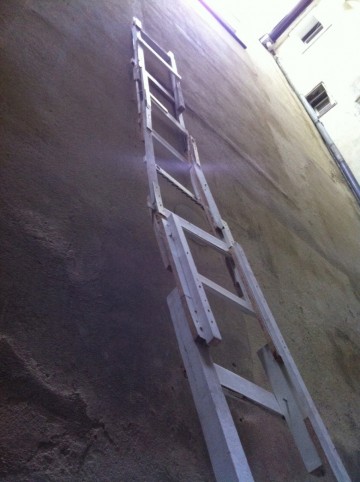huber.huber
NEHMEN SIE ZWEI MAL PRO TAG ASPIRIN
August 31, 2012 – October 13, 2012
History and archaeology have profoundly documented how man has sought help and used instruments in its daily struggle for survival. The vast and refined assortment of man’s tool kit in comparison to other species on this planet is extraordinary. And while animals and plants are considered an integral part of nature, mankind places itself above it. The use of tools and mechanisms are to be understood in terms of this polar constellation. It is in this conflicting relation of uneven powers that mankind tries to subdue and to control nature.
The ‘Ehegraben’ is nowadays a cul-de-sac, a captive courtyard that contains one spot functioning as an entrance and an exit. The white ladder that huber.huber have placed against the wall is by far not long enough to reach out of the yard. In fact the insufficient length of the ladder that has been constructed by driftwood evokes helplessness and despair. The prospects of escape and rescue are even worsened when one imagines the ladder and the picture of the grey sky on the invitation card. In ‘Nehmen sie zwei Mal pro Tag Aspirin’ (Take an aspirin twice a day) huber.huber refer superbly to the delusive certainty of reliable help for life: the ladder as one of the most simple and oldest instruments and Aspirin, one of the most simple and oldest industrial remedies.
Two worlds are being united in ‘Presbyterium’ (presbytery) to one seemingly powerful instrument. The term presbytery describes on the one hand the chorus of a church and on the other hand it means the assembly of the elders. This body of elected elders ensures that the community submits to the authority of the Bible and to the sovereignty of God. huber.huber have mounted into this spiritual and real space images of machines. Massive turbines rise up high in front of the community at the altar where the priest usually stands and preaches. As sovereign, authority and reference these technical machines guarantee modern-day control over nature and chaos. That nowadays blunt ‘tool’ called religion serves as a familiar shell and platform for the new saviour. The hint to the golden calf is inevitable, fascinating and intentionally irritating.
The ‘Ehegraben’ is nowadays a cul-de-sac, a captive courtyard that contains one spot functioning as an entrance and an exit. The white ladder that huber.huber have placed against the wall is by far not long enough to reach out of the yard. In fact the insufficient length of the ladder that has been constructed by driftwood evokes helplessness and despair. The prospects of escape and rescue are even worsened when one imagines the ladder and the picture of the grey sky on the invitation card. In ‘Nehmen sie zwei Mal pro Tag Aspirin’ (Take an aspirin twice a day) huber.huber refer superbly to the delusive certainty of reliable help for life: the ladder as one of the most simple and oldest instruments and Aspirin, one of the most simple and oldest industrial remedies.
Two worlds are being united in ‘Presbyterium’ (presbytery) to one seemingly powerful instrument. The term presbytery describes on the one hand the chorus of a church and on the other hand it means the assembly of the elders. This body of elected elders ensures that the community submits to the authority of the Bible and to the sovereignty of God. huber.huber have mounted into this spiritual and real space images of machines. Massive turbines rise up high in front of the community at the altar where the priest usually stands and preaches. As sovereign, authority and reference these technical machines guarantee modern-day control over nature and chaos. That nowadays blunt ‘tool’ called religion serves as a familiar shell and platform for the new saviour. The hint to the golden calf is inevitable, fascinating and intentionally irritating.

